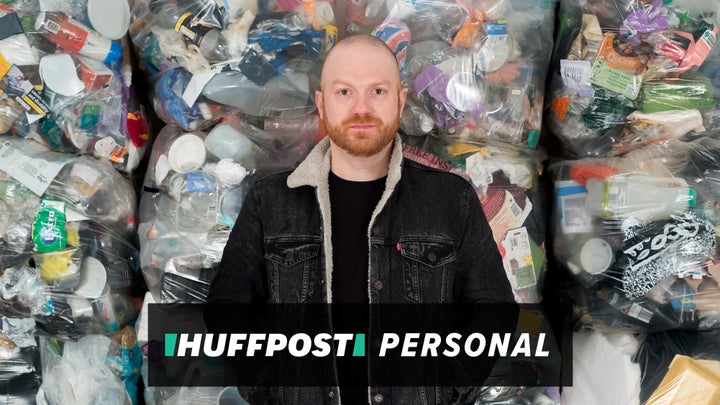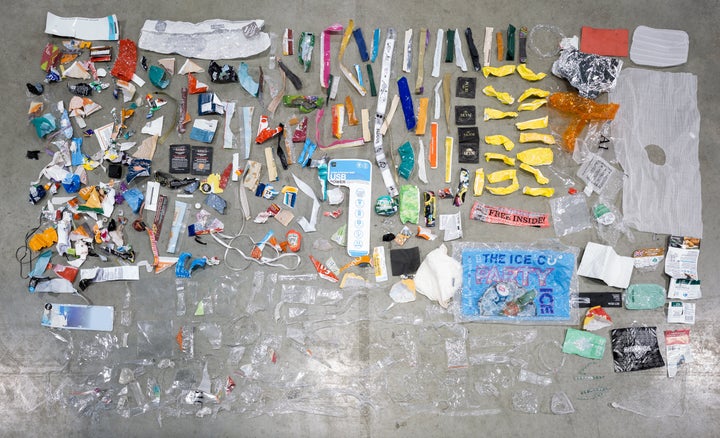
When I moved to the seaside town of Margate, Kent in 2016, I remember being struck by the swathes of plastic I could see washed up on the beach as I walked along.
I had already become more conscious of the massive amounts of packaging we’re confronted with at the supermarket, but this sight – twinned with the fact that I wasn’t offered any recycling at my new home – made me realise there seemed to be no way to dispose of my plastic responsibly. So, I chose to embrace that and conduct a little experiment: to store all of the plastic waste I generated for a year to see just how much was creating.
A year later, 22 large bin bags sat in my flat, filled to the brim with my discarded plastic items, from milk cartons to crisp packets to a giant inflatable watermelon. With each piece I hung onto and stashed, I asked myself plenty of questions about exactly what I was doing: how much plastic do I throw away? Does any of it end up in the sea? Is it all necessary? And how much actually gets recycled?
“Such is the nature of our fast-moving throwaway society, I barely remembered using any of it. It was at that moment that I felt an overwhelming responsibility to share what I’d discovered.”
There was no way I could figure out these answers on my own, so I asked for help. I got in touch with Dr Julie Schneider, an earth scientist and researcher, who helped me to count, weigh, categorise and analyse every single piece I had collected over the last 12 months.
Needless to say, the results weren’t pretty.
Of the 4,490 pieces of plastic I threw away over the course of a year – that’s about 12 pieces a day on average – 93% was single-use packaging. Over two-thirds was used to wrap or cover or consume food and drink. Shockingly, according to Dr Schneider only 4% would be recycled in the UK. Give or take a few per cent, and this likely applies to your plastic waste too.
After I’d emptied my year-long collection of plastic waste from the 22 bin bags I’d accumulated, filling the floor of a massive warehouse with thousands of familiar products and brands, I was struck by shock and sadness. This was all the stuff I’d bought, used and chucked away in just one year. Such is the nature of our fast-moving throwaway society, I barely remembered using any of it. It was at that moment that I felt an overwhelming responsibility to share what I’d discovered.

After setting up Everyday Plastic in 2018, I was commissioned to make a giant mural with photographer Ollie Harrop, before Julie and I co-authored What we throw away and where it goes – a seminal report based on rigorous analysis of my collection. The report’s core purpose was accessibility. No matter if you were a primary school student or a multinational CEO, we needed to communicate this clearly.
When I was preparing for this project, I read a report that there will be more pieces of plastic than fish in our seas by 2050. A scary fact, but also pretty abstract and bewildering to understand. While this is taken from hugely important research, it also complicates the story and alienates the majority. To get to grips with the plastic problem, what we really need to do is relate and understand each other’s behaviours, choices and attitudes to plastic waste before we can even begin to address them.
Collecting my plastic waste for a year certainly says a lot about my personal choices and buying habits, but it also says a lot about us as a society. We’re sleepwalking through supermarket aisles, giant shopping centres and online retailers, almost aimlessly consuming without a second thought of where the product we’re holding comes from, or where it will end up.
“We need to take back control of our decision-making from the hands of marketers, advertisers, retailers, shareholders and policy-makers”
To repurpose a somewhat stale slogan, we need to take back control of our decision-making from the hands of marketers, advertisers, retailers, shareholders and policy-makers. Impulse buys, retail therapy and convenience stores are etched into our everyday language, but really they’re just catchy phrases that have been dreamed up in boardrooms. And I say this as someone who worked in marketing for ten years.
One year on from the release of our report, I’ve seen how the public conversation around waste is certainly livelier – brands are launching plastic-free initiatives every day, and game-changing government consultations such as Deposit Return Scheme and the Plastic Packaging Tax are big steps forward. However, sales of bottled water have increased in the UK and plastic production continues to rise globally with current levels expected to triple by 2050. There is a long way to go, but at least we are on the right road.
One of my main motivations for establishing Everyday Plastic was to help us regular people find a more personal connection to this urgent environmental issue, to offer the public the same experience I had so they can fast-track their awareness and understanding about what we’re doing to the planet. Which is why in 2020, I’ll be launching the Everyday Plastic Survey, which will encourage you and thousands of other people across the country to collect your plastic waste (don’t worry, just for a week), analyse it at home or at school or at work or even among your friends and family, and then enter the results into our online platform.

Just like how Dr Schneider helped me understand exactly what happens to my plastic, this will then automatically generate your personalised plastic footprint. The footprint will show you how much of your weekly plastic waste will be recycled or exported or burned, how much is food packaging, single-use packaging, as well as the scale of your consumption. It illustrates how the magnitude of the global plastic problem can be scaled right down to the individual, and help us realise it’s everyone’s responsibility. But crucially, it will show each person where they can make the quick and simple changes. If you stop buying a bottle of water per day and switch to a reusable one, we could safely assume that you could prevent 365 water bottles from entering the waste system.
Confronting my personal plastic footprint forced a hard realisation which has genuinely changed my life. The whole process has mobilised me to change my behaviour, reduce my consumption and become an active campaigner through Everyday Plastic.
I firmly believe that things like the Everyday Plastic Survey can fundamentally change how we consume, and what we want and expect from our businesses and policymakers too. But most importantly, it can show that our individual actions – when taken together – can make an enormous difference.
Daniel Webb is founder of Everyday Plastic. Find out how you can take part in the Everyday Plastic Survey 2020 by visiting everydayplastic.org
Have a compelling personal story you want to tell? Find out what we’re looking for here, and pitch us on ukpersonal@huffpost.com